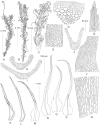On the Cryptic Speciation in the Mosses with East Asia-East North America Disjunction: A Case Study of Two Poorly Understood Mosses from the Southern Extremity of the Russian Far East
- PMID: 39771256
- PMCID: PMC11678183
- DOI: 10.3390/plants13243558
On the Cryptic Speciation in the Mosses with East Asia-East North America Disjunction: A Case Study of Two Poorly Understood Mosses from the Southern Extremity of the Russian Far East
Abstract
A survey of the moss flora of the southernmost part of the Russian Primorsky Territory yielded several intriguing taxa, whose identity is assessed herein based on an integrative morpho-molecular approach. Bellibarbula recurva was previously known in inland Asia only from the Sino-Himalayan region and the new locality is distant from the earlier known ones to ca. 3000 km. Despite the morphological uniformity, Russian specimens are remarkably distinct in sequences of all three obtained DNA markers, approaching an American specimen in the rps4 sequence. Another probable relic, Symblepharis cf. crispifolia, appeared to be fairly common in the southern part of the Primorsky Territory, where low mountains are covered with hard-leaved forests. Russian specimens of Symblepharis cf. crispifolia var. brevipes show significant divergence from S. crispifolia s.str., which also has complex phylogenetic structure, obscuring further taxonomic implications. The description and illustrations of both taxa based on Russian specimens are provided, and the area, where both species occur, is briefly characterized; it includes numerous thermophilous species, which are rare or do not occur northwards. Our case study uncovers the problem of cryptic speciation within species distributed in temperate climate and is considered to represent relics of Arcto-Tertiary flora.
Keywords: DNA barcoding; arcto-tertiary flora; biodiversity; biogeography.
Conflict of interest statement
The authors declare no conflict of interest.
Figures




References
-
- Ignatov M.S., Ignatova E.A., Cherdantseva V.Y. Oedipoium griffithianum (Oedipodiaceae, Musci)—New Species and New Class for Russian Flora. Arctoa. 2006;15:211–214. doi: 10.15298/arctoa.15.10. - DOI
-
- Ignatov M.S., Suzuki T., Cherdantseva V.Y. Fissidens hyalinus (Fissidentaceae, Bryophyta), a New Species for Russia. Arctoa. 2007;16:123–126. doi: 10.15298/arctoa.16.10. - DOI
-
- Ignatov M.S., Dugarova O.D., Fedorova A.V., Ignatova E.A. Lazarenkoa, a new moss genus from the Russian Far East. Arctoa. 2019;28:226–230. doi: 10.15298/arctoa.28.21. - DOI
-
- Afonina O.M., Cherdantseva V.Y., Ignatova E.A., Ignatov M.S. Symblepharis vaginata (Dicranaceae, Bryophyta), a new genus and species for the moss flora of Russia. Bot. Zhurn. 2010;12:1765–1770.
-
- Fedosov V.E., Pisarenko O.Y., Bakalin V.A. Venturiella sinensis (Erpodiaceae, Bryophyta), a new species and a sew family for the moss flora of Russia. Arctoa. 2016;25:364–368. doi: 10.15298/arctoa.25.28. - DOI
Grants and funding
LinkOut - more resources
Full Text Sources
Miscellaneous

